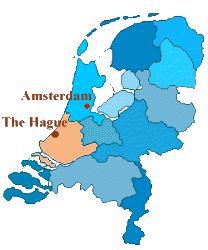About The Netherlands (Holland)
Netherlands, also known unofficially
as Holland, country in
northwestern Europe, west of Germany and north
of Belgium.
The Netherlands Antilles and Aruba, islands
in the Caribbean Sea,
are part of the Netherlands. The European
portion of the Netherlands
has a total area of 41,526 sq km (16,033 sq
mi). The capital and
largest city is Amsterdam.
Land and Resources
The Netherlands is a low-lying country,
about half of which is
below sea level. The coastline consists mostly
of dunes, behind which
lies the land below sea level, protected from
flooding by a systems of
dikes, dams, and locks. It iskept dry by continuous
mechanical pumping.
The country's largest lake, the IJsselmeer,
is an artificial lake created as
part of a continuing project to reclaim land
from the sea. Major rivers
include the Rhine, the Maas, and the Schelde,
which form a delta covering
much of the country and provide shipping access
to the interior of Europe.
The Netherlands has a temperate maritime climate.
Because land is scarce
and fully exploited, areas of natural vegetation
are limited. The remnants of
forests are carefully managed. Grasses and
heather provide habitats for
rabbits, but larger wildlife has disappeared.
Population
With a population of 15,649,729 (1997 estimate),
the Netherlands is one of
the world's most densely populated countries.
Some 89 percent of the people
live in urban areas. The great majority of
inhabitants are Dutch, but the Frisians
constitute a distinct cultural and linguistic
group.
Similarly, the official language
is Dutch, but Frisian is also spoken. Roman
Catholics constitute about 33
percent and Protestants 23 percent of the
population; about 39 percent of the
people are not church members.
Education and Cultural Activity
About one-third of schools are public; about
two-thirds are nonpublic, mainly
operated by religious institutions. Both are
publicly financed. Attendance is
compulsory from ages 5 to 16.
Economy
Trade is an essential part of the economy.
Goods flow into the ports of Rotterdam
and Amsterdam, where canals and rivers provide
easy access to the interior of
Europe. Industrial production was relatively
unimportant until the development
of chemical and electronics industries after
World War II (1939-1945). After
the war, Rotterdam became a leading center
for refining petroleum, and in recent
decades the Netherlands has become the world's
fifth largest exporter of natural
gas. Despite the poor soil of the Netherlands,
family farms are a major generator
of exports. The Dutch currency is the guilder
(1.84 guilders equal U.S.$1;1998).
|




